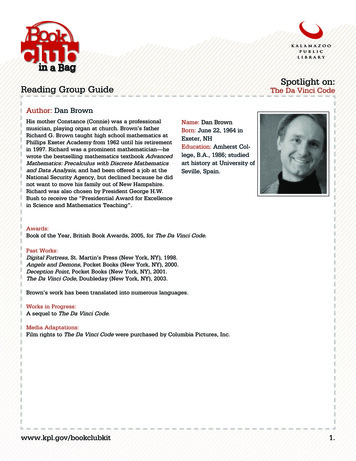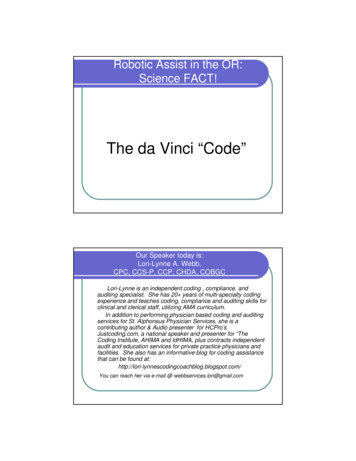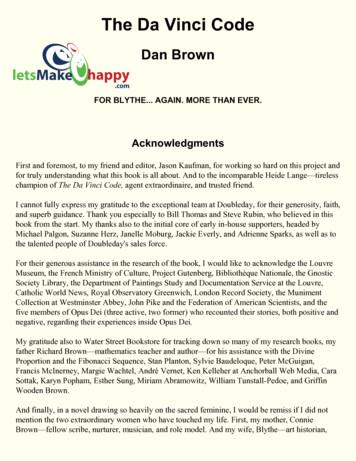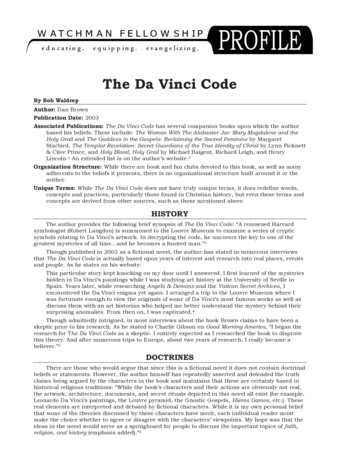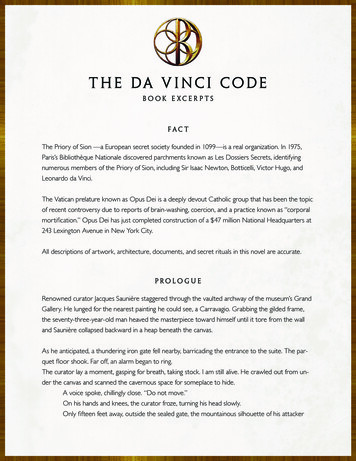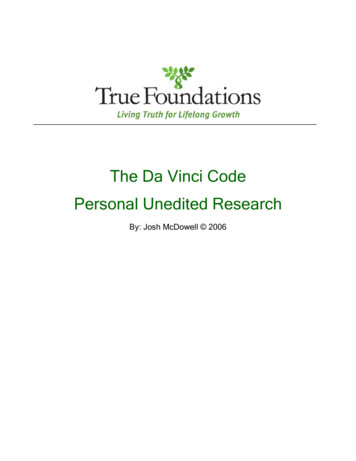
Transcription
The Da Vinci CodePersonal Unedited ResearchBy: Josh McDowell 2006
OverviewJosh McDowell’s personal research on The Da Vinci Code was collected inpreparation for the development of several equipping resources released inMarch 2006.This research is available as part of Josh McDowell’s Da Vinci PastorResource Kit. The full kit provides you with tools to equip your people toanswer the questions raised by The Da Vinci Code book and movie. We trustthat these resources will help you prepare your people with a positivereadiness so that they might seize this as an opportunity to open upcompelling dialogue about the real and relevant Christ.Da Vinci Pastor Resource KitThis kit includes:- 3-Part Sermon Series & Notes- Multi-media Presentation- Video of Josh's 3-Session Seminar on DVD- Sound-bites & Video Clip Library- Josh McDowell's Personal Research & NotesRetail Price: 49.95The 3-part sermon series includes a sermon outline, discussion points andsample illustrations. Each session includes references to the slidepresentation should you choose to include audio-visuals with your sermonseries. A library of additional sound-bites and video clips is also included.Josh McDowell's delivery of a 3-session seminar was captured on video andis included in the kit. Josh's personal research and notes are also included.This extensive research is categorized by topic with side-by-side comparisonto Da Vinci claims versus historical evidence.For more information and to order Da Vinci resources by Josh McDowell, ons.comPage 2
Table of ContentsIntroduction: The Search for Truth. 4Historical Chart: Claims vs. Fact . 7Christianity borrowed from pagan mythology . 7The Sacred Feminine. 10Priory of Sion. 14Knights Templar . 18The Bible is man-made . 23The Council of Nicaea Concerning the books to include in the New Testamentcanon . 25What were the early Christians like? . 70Was the early church anti-feminine? . 76Constantine and The Council of Nicaea Concerning Jesus’ deity . 81Did Christ command that Mary Magdalene should lead the Church?. 95Did Mary Magdalene bear Christ’s child?. 97Christ’s royal bloodline . 99The Holy Grail . 102The Last Supper Painting. 103Other pieces of artwork . 106Da Vinci Code & Jesus Christ . 108Leonardo da Vinci Unplugged . 145General. 145Leonardo's use of iconography indicating the Passion of the Christ . 145Views on death, his Catholic funeral, his will, and the soul . 146Regarding the Catholic Church and his belief in the crucifixion . 149Leonardo's personal beliefs regarding God, the Soul . 149The Last Supper . 152The need for restoration. 155Leonardo's asceticism, views on humanity modesty, propriety, intimacy,vegetarianism, care for animals, love of pranks. 157Inquisitive and Scientific approach. 160Virgin Of the Rocks, the Lourve and London versions . 160Mona Lisa . 161Madonna, Child, St. Anne and a Lamb . 162Bibliography. 162Leonardo's Manuscripts. 163Paris Manuscripts: . 163Other notebooks and manuscripts and cited sources: . 163Closing Notes on Leonardo Research . 164http://www.truefoundations.comPage 3
Introduction: The Search for TruthThere is no question or doubt that Dan Brown has written a spell-binding novel. We alllove a good story, but even more, we love “a good conspiracy.”As we indulge in the “conspiracy,” we also need to begin the “quest” and “search for thetruth.” Dan Brown needs to be congratulated on his great writing and the ability toproduce a thriller that is so hard to put down. Multitudes of authors envy his writingability.Over the years while lecturing in more than 1000 universities in 107 different countries, Ihave had the opportunity to participate in more than 250 debates with scholars,historians, and philosophers.I never enter the research phase to "win the debate," but rather to find the truth. As Iexamine the material relevant to the theme of the debate, I have to ask myself severalquestions:1) Is this the truth or is it someone's personal opinion, bias, or prejudice?2) Is there sufficient credible evidence to support the truth claim?3) Is it relevant to the argument?For me to be energetic in a debate and to speak with authority, I must be convinced inmy own mind that my position is valid and intellectually defensible. If I have developedthe arguments skewed by my own personal bias or prejudice, or twisted the facts tosupport my position, then it shouldn't take a worthy opponent long to expose me and winthe debate.As a believer in Christ, I am committed to the Truth. Jesus said in John 8:32, "You shallknow the truth." He did not say you should ignore the truth or distort the truth. If anyoneshould be committed to knowing and following the truth, it is a Christian.As a university student, I was an obnoxious, antagonistic agnostic. During my pursuit toexpose the Christian faith as an “historic construct” by his followers, I was confrontedwith historical evidence about Jesus being the Son of God and the Bible being reliableand accurate. This evidence not only appeared to be "credible" but it also ran contraryto my position and to what I was so passionately wanting to prove.Finally, the evidence compelled me to change my attitude and my viewpoint. I no longerpursued the "truth" to refute Christianity, but rather to simply ask the question, “Is ittrue?” and then let the evidence speak for itself. It was through this process that I cameto Christ.It was imperative that we approach the historic claims of The Da Vinci Code in the sameway. People perceive the book as a fictional novel based upon "fact."http://www.truefoundations.comPage 4
********************DAN BROWN MAKES CLAIMS THAT THE NOVEL IS HISTORIC FACT.********************NBC Today – October 10, 2005Dan Brown was asked by host Matt Lauer, "How much of this [book] is based on realityin terms of things that actually happened?" Brown emphatically replied, "Absolutely allof it. is historical fact."********************ABC Good Morning America – November 3, 2003Host Charlie Gibson said to Dan Brown, "This is a novel. If you were writing it as a nonfiction book, how would it have been different?" Brown responded,"I don't think it would have."*********************USA TodayThe Da Vinci Code is"Historic fact with a contemporary storyline."(Bob Minzesheimer, “Code Deciphers Interest in Religious History,”December 11, 2003, pD1)**********************Another comment refers to the work as"A good yarn within a richly factual context."(“The Da Vinci Code: Book -da-vinci-code.html)***********************"The most amazing thing about this novel [The Da Vinci Code]is that it's based on fact."(Taylor, www.archive.salon.com/books/review/2003/03/27da vinci)***********************It is "A fact-based thriller."(Valerie MacEwen, “Try Pulling This Book -code.shtml)Dan Brown set the stage for you and me to enter The Da Vinci Quest and evaluate the"facts." Brown says, “each individual reader must explore these characters’ viewpointsand come to his or her own interpretations." (Dan Brown, “The Da Vinci Code,” Doubleday: NewYork, NY, 2003)http://www.truefoundations.comPage 5
It is my hope that as you analyze the “facts” Dan Brown sets forth in The Da Vinci Codethat this research will provide the reliable and credible evidences you need to “know thetruth.” I also pray that, like me, you will come to appreciate and love God’s Word moreand more every day.That people might know Him,Josh D. McDowellhttp://www.truefoundations.comPage 6
Historical Chart: Claims vs. FactSubjectDa Vinci CodeClaimHistorical FactCHRISTIANITY BORROWED FROM PAGAN MYTHOLOGY“Nothing inChristianity isoriginal. The preChristian GodMithras—called theSon of God and theLight of the Worldwas born onDecember 25, died,was buried in a rocktomb, and thenresurrected in threedays. By the way,December 25 is alsothe birthday ofOsiris, Adonis, andDionysus. Thenewborn Krishnawas presented withgold, frankincense,and myrrh. EvenChristianity’s weeklyholy day was stolenfrom the pagans.”(p232)“By fusing pagansymbols, dates, andrituals into thegrowing Christiantradition, he[Constantine]created a kind ofhybrid religion thatwas acceptable toboth parties.” (p232)Bruce Metzgerhttp://www.truefoundations.comSpecific myths about Mithras’ miraculous birth andbecoming a ‘savior god’ were modeled after thestories of Jesus and developed after Christianitycame to Rome in the first century.It is not until at least the second century, if not thethird century A.D., that there is sufficient sourcematerials to reconstruct a reliable semblance of thepagan mystery religions.“Far too many writers use this late source material(after A.D. 200) to form reconstructions of thethird century mystery experience and thenuncritically reason back to what they think musthave been the earlier nature of the cults”, writesRonald Nash. (Ronald Nash, “Was the NewTestament Influenced by Pagan Religions?”Christian Research Journal, Winter 1994.Accessed online at www.equip.org)Indeed, it is a question of who influenced who. WithChristianity exploding onto the scene of the RomanEmpire, it is evident that other religions adoptedcertain teachings or practices from Christianity inorder to stem the tide of departing adherents and/orto attract Christians to their side.Dr. Bruce Metzger, Professor Emeritus of PrincetonTheological Seminary, gives an accurateassessment in his article on this subject, “MysteryReligions and Early Christianity”:“In what T. R. Glover aptly called the “conflict ofPage 7
SubjectDa Vinci CodeClaimHistorical Factreligions in the Early Roman Empire,” it was to beexpected that the hierophants of cults which werebeginning to lose devotees to the growing Churchshould take steps to stem the tide.”(Metzger, MREC, 11)Available evidences show that Mithraism did notgain a foothold in the Roman Empire until after A.D.100.No Mithraic monument can be dated earlier than theend of the first century A.D., and even the moreextensive investigations at Pompeii, buried beneaththe ashes of Vesuvius in A.D. 79, have not so farproduced a single image of the god.Justin MartyrNo wonder Justin Martyr (c.a. 160 A.D.) as RonaldNash notes,“referred to the Mithraic meal as a satanicimitation of the Lord’s supper.” (First Apology, 66)One other key to understanding the deception thatmany, including Brown, have used is called “coloringthe evidence.” Ronald Nash observes,“One frequently encounters scholars who first useChristian terminology to describe pagan beliefsand practices and then marvel at the awesomeparallels they think they have discovered.” (Nash,CHW, 126)A host of scholars, including Nash, E.O. James,Bruce Metzger, Günter Wagner, and Hugo Rahner,point out that the pagan mystery religions were quitedifferent from Christianity in significant ways. Thosepagan mystery religions, which flourished in the thirdand fourth centuries, were based on an annualvegetation cycle; they stressed esoteric (hidden)knowledge; they emphasized emotional ecstasy overdoctrine and their central goal was mysticalexperience. They were also very synchronistic,taking elements from other pagan movements andshedding beliefs with little regard for any establishedteaching or belief system – completely contrary to theapostolic tradition so intensely guarded byChristians. (see Nash, Gospel and the Greeks, 105–20).Bruce Metzgerhttp://www.truefoundations.com“Unlike the deities of the Mysteries, who werePage 8
SubjectDa Vinci CodeClaimHistorical Factnebulous figures of an imaginary past, the DivineBeing, whom the Christian worshipped as Lordwas known as a real Person on earth only a shorttime before the earliest documents of the NewTestament were written. From the earliest times,the Christian creed included the affirmation thatJesus “was crucified under Pontius Pilate.” Onthe other hand, Plutarch thinks it necessary towarn the priestess Clea against believing that“any of these tales [concerning Isis and Osiris]actually happened in the manner in which theyare related.” (Metzger, Historical and LiteraryStudies, 13.)Certainly no early texts refer to any resurrection ofAttis orlink the worship of Adonis to a resurrectionNor is the case for a resurrection of Osiris anystronger After Isis gathered together the pieces of Osiris’sdismembered body, he became “Lord of theUnderworld.” According to Plutarch, it was the pious desire ofdevotees to be buried in the same ground where,according to local tradition, the body of Osiriswas still lying.French scholar Andre Boulanger concludes: “Theconception that the god dies and is resurrected inorder to lead his faithful to eternal life is representedin no Hellenistic mystery religion.” (Nash, CHW, 172173)Sabbath“Christianityhonored the JewishSabbath ofSaturday, butConstantine shiftedit to coincide withthe pagan’sveneration day ofthe sun. To this day,most churchgoersattend services onSunday morninghttp://www.truefoundations.comHere Johnson refers in part to the fact that theChristians have been celebrating their weekly liturgyon Sunday, the first day of the week, since the timeof Paul and the other apostles. Sunday was also thefeast day of the Sol Invictus (Invisible) cult, whoseworship of the pagan sun god had appeared in theRoman world, around the middle of the secondcentury, and had been strongly supported byEmperor Aurelian. (A.D.270 – 275). (Chas S.Clifton, Encyclopedia of Heresies and Heretics, NewYork: Barnes & Noble, 1992, 121)Page 9
SubjectDa Vinci CodeClaimHistorical Factwith no idea thatthey are there onaccount of thepagan sun god’sweekly tribute—Sunday.” (pp232233)THE SACRED FEMININE“The ancientsenvisioned theirworld in two halvesmasculine andfeminine. TheirGods andGoddesses workedto keep a balance ofpower. Yin andyang.” (p36)The beliefs about the early Church, gnosticism, andMary Magdalene set forth in Brown's novel dateback to the 19th century and the advent of modernfeminism. Philip Jenkins, points out, in HiddenGospels: How The Search For Jesus Lost Its Way,that"late nineteenth-century activists saw Jesus andhis first followers as protofeminists, whose radicalideas were swamped by patriarchal orthodoxy."In addition to feminists, this"idea that the Gnostics retained the core truths ofa lost Christianity was commonplace amongoccult and esoteric writers, many of whom sharedthe contemporary excitement over women'ssuffrage and other progressive causes."These writers looked to heretical, gnostic forms ofearly Christianity for material to bolster their beliefthat Jesus was really a radical feminist, that thechurch was initially founded as an egalitarian andnon-dogmatic body, and that women were amongthe first apostles -- or, as in the case of MaryMagdalene, the primary apostles. (Philip Jenkins,Hidden Gospels: How the Search for Jesus Lost It'sWay, New York: Oxford University Press, 2001,125).The Pentacle“This pentacle is therepresentative of thefemale half of allthings — a conceptreligious historianscall the ‘sacredfeminine’ or the‘divine irst, from authoritative sources we know that thereis no single interpretation of the pentacle. Evenwithin Wicca “there seems to have been no singletradition concerning their meaning and use In manycontexts they seem simply to have been decorative Another Wiccan, Doreen Valiente says,“The origin of the magical five-pointed star is lostin the mists of time.” (Valiente, AWPP, 306).Page 10
SubjectDa Vinci CodeClaim“In its most specificinterpretation, thepentacle symbolizesVenus-the goddessof female sexuallove and beauty.”(p36)Historical Fact Pythagoras, the Greek mathematician (570-495B.C, interpreted it to mean “health.”Empedocles (490-430 B.C) used it to mean spirit,earth, air, fire, and water. (Grimassi, EWW, 285)Even modern neopagans use it to representspirituality over materialism. (Cuhulian, FCM,103)Needless to say, we have no evidence whatsoeverto believe that the pentacle represents the sacredfeminine.Olympics as atribute to VenusShekinahgoddess“As a tribute toVenus, the Greeksused her eight-yearcycle to organizetheir Olympicgames. . . the fouryear schedule ofmodern Olympicsstill followed thehalf-cycles ofVenus. . . the fivepointed star hadalmost become theofficial Olympic sealbut was modified atthe last moment-itsfive pointsexchanged for fiveintersecting rings.”(pp36-37)“Early Jewsbelieved that theHoly of Holies inSolomon’s Templehoused not onlyGod but also hispowerful femaleequal, Shekinah.Men seekingspiritual wholenesshttp://www.truefoundations.comConcerning the Olympics, its historical sourcesmake clear they were a tribute to Zeus, not Venus.1(M.I. Finley and H.W. Pleket, The Olympic Games: The FirstThousand Years, New York: Viking, 1976; J. Kieran and A.Dailey, The Story of the Olympic Games, Philadelphia:Lippincott, 1977; B. Henry and R. Yeoman, An Approved Historyof the Olympic Games, (Sherman Oaks, CA: Alfred, 1984; andAllen Guttmann, TheOlympics: A History of the ModernGames,Urbana, IL: University of Illinois Press, 1992).The Olympic seal (the five rings) has nothing to dowith the pentacle. It is a modern symbol, designedby Baron Pierre de Coubertin in 1913. It was madeto represent the five continents. This logo was finallyaccepted in 1920. (TRORNSA)Again, there is no evidence whatsoever that theancient pagans worshipped goddesses. But Brown’spremise that the world was like this all the way untilConstantine decided to change what everybodybelieved is just not true. It was not a part of Jewishtradition.Yes there was a problem in Jewish history withtemple prostitution, but this was clearly against theLaw of Moses, the prophets, and Jewish tradition. ItPage 11
SubjectTetragrammatonDa Vinci CodeClaimHistorical Factcame to the Templeto visit priestessesor hierodules withwhom they madelove andexperienced thedivine throughphysical union.was actually the adoption of Canaanite rituals, whichMoses sternly warned them against (Deut. 23:1718). Jewish tradition represented by Kings likeDavid, Asa, and Josiah supported the worship of andallegiance to one God, Jehovah.The JewishtetragrammatonYHWH-the sacredname of God-in factderived fromJehovah, anandrogynousphysical unionbetween themasculine Jah andthe pre-Hebraicname for EveHavah” (p309)Speaking of Jehovah, Brown says that YHWH camefrom the word Jehovah. This is exactly backwards.Ancient written Hebrew had no vowels. So the “original” covenant name of God wasYHWH. Inserting the vowels from “Adonai” (my Lord).Yahowah. When that word was Latinized, around1270 A.D., the Y changed to a J and the W to a V.Thus, we now have Jehovah.Again, it is apparent that Dan Brown’s facts behindhis fiction are in many cases exactly opposite of thetruth. We’ll see more of it ahead. The big picturehere, that Dan Brown is trying to present, despite thefacts, is one of pagan goddess worship which wouldhave called the ancient Hebrew prophets to scoff indisgust. He writes:“The goddess Venus and the planet Venus wereone and the same. The goddess had a place inthe nighttime sky and was known by manynames—Venus, the Eastern Star, Ishtar, Astarte—all of them powerful female concepts with ties toNature and Mother Earth.” (p36)Some 1400 years before Jesus was born, Mosessternly warned the Jewish people and set aprecedent for all time for the worshippers of the livingGod:“So watch yourselves carefully, since you did notsee any form on the day the Lord spoke to you atHoreb from the midst of the fire, so that you do notact corruptly and make a graven image foryourselves in the form of any figure, the likenessof male or female, . And beware not to lift up yourhttp://www.truefoundations.comPage 12
SubjectDa Vinci CodeClaimHistorical Facteyes to heaven and see the sun and the moonand the stars, all the host of heaven, and bedrawn away and worship them and serve them .”(Deuteronomy 4:15, 16, 19)The Hebrewword:“Shekinah”In attempting to bolster his case for the sacredfeminine, Brown retranslates the Hebrew wordShekinah to mean another deity, a female one,matched with and counter-balancing the male deity,Yahweh (p446). But if Yahweh was the male deity,why did Brown previously assert that Yahweh(YHWH) was itself “an androgynous physical unionbetween the masculine Jah and the pre-Hebraicname for Eve, Havah”? (p309)This whole effort to make God feminine betrays ahuman-centered way of thinking about God. God’sgender was never an issue; in fact it is a total nonissue, which was meant to carry over into humanrelationships in Christ. The apostle Paul warnedagainst thinking in gender terms with respect tospirituality when he wrote in or about A.D. 48,“There is neither Jew nor Greek, there is neitherslave nor free man, there is neither male norfemale; for you are all one in Christ Jesus.(Galatians 3:28)Returning to Brown’s claim that Shekinah was afemale deity worshiped alongside of Yahweh, thistranslation is gaining popularity without any groundsfor its truth. One website (accessed 9/16/05)http://shekinah.elysiumgates.com/ yielded thefollowing reinterpretation of the Hebrew “Shekinah”:Among the Hebrews one of the traditional names ofGod is the Shekinah, and, interestingly, it is a femininegender noun. Many Hebrews saw her as the mother orfeminine aspect of God. Lamentations 1:5, "Herchildren are gone into captivity," and immediately after1:6, "From Zion her splendour is departed." (Note theuse of "her" for God and "splendour" is also one of theways to describe the Shekinah).Nothing could be further from the truth!http://www.truefoundations.comPage 13
SubjectDa Vinci CodeClaimHistorical FactAnyone reading Lamentations, chapter one, canimmediately tell from the very first verse on that “her”refers to the city of Zion as representative of thenation of Judah. Shekinah appears nowhere in thepassage.Shekinah is “A term referring to the ‘glory of God.’The idea that this term is paired with the name ofGod, Yahweh, so that a male (Yahweh) and female(Shekinah) counterpart exists with God, is simplefabrication.PRIORY OF SION“FACT: The Prioryof Sion – a Europeansecret societyfounded in 1099 – isa real organization.In 1975 Paris’sBibliothequeNationalediscoveredparchments knownas Les DossiersSecrets, identifyingnumerous membersof the Priory of Sion,including Sir IsaacNewton, Botticelli,Victor Hugo, andLeonardo da Vinci.”Formed in 1956“The Priory of Sion was founded inJerusalem in 1099by a French kingnamed Godefroi deBouillon,immediately after hehad conquered thecity King Godefroiwas allegedly thepossessor of apowerful secret[Christ’ marriage toMary Magdalene] – ahttp://www.truefoundations.comKing Godefroi did start an organization afterconquering Jerusalem. It was a group of monksknown as the Ordre de Notre Dame de Sion whichmeans, Order of Our Lady of Zion, but it ceased in1617. (The Truth Behind The Da Vinci Code –Richard Abanes)A Father Vincent wrote of this group in 1698. Hewrote,“There were in Jerusalem during the Crusades . . .knights attached to the Abbey of Notre Dame deSion who took the name of Chevaliers de l’Ordrede Notre Dame de Sion(Knights of the Order ofOur Lady of Zion).” (Laura Knight-Jadczyk, “TheGrail Quest and The Destiny of Man-Part V-g: ThePriory of Sion,”www.cassiopaea.org/cass/grail 5g.htm)The actual name the “Priory of Sion” is notmentioned until 1956 when Pierre Plantard started asocial club “devoted to the cause of Low-CostHousing”. (Paul Smith, “Priory of Sion Debunked,”www.anzwers.org/free/pos/debunking/ )After that Priory ended, Plantard started another onein the early 1960’s. The intent of this Priory was tobring back the French monarchy. They tried to buildoff the rumor that there was a hidden royal bloodlinein France, by planting forged papers in libraries.(Paul Smith, “Priory Documents and Articles linkedwith Pierre Plantard, Thomas Plantard and Pillipe deCherisey,” www.priory-of-sion.com/psp/id24.html)Page 14
SubjectDa Vinci CodeClaimsecret that had beenin his family sincethe time of Christ.Fearing his secretmight be lost whenhe died, he foundeda secretbrotherhood-thePriory of Sion – andcharged them withprotecting his secretby quietly passing iton from generationto generation TheLegend iscomplicated, but theimportant thing toremember is thatthe Priory guardsthe proof, and ispurportedly awaitingthe right moment inhistory to reveal thetruth.” (pp157-161)“The Priory’smembership hasincluded some ofhistory’s mostcultured individuals:men like Botticelli,Sir Isaac Newton,Victor Hugo . . .And, Leonardo daVinci Da Vincipresided over thePriory between1510 and 1519 asthe brotherhood’sGrand Master,”(p113).Historical FactPlantard appeared on BBC television as a Templarexpert in 1979. He came to the attention of MichaelBaigent and his partners, resulting in the publicationof Holy Blood, Holy Grail (1982) and The MessianicLegacy (1986).The authors believed Plantard’s pretensions that thePriory was a marvelously astute society numberingthousands of important people, while guarding asecret that would topple the Catholic Church.How did they maintain such strict secrecy thatacademic historians of occult movements such asthe magisterial Frances Yates failed to hear of them?Why did they leave no record before the twentiethcentury? Is this another case of the clichéd claim:“The secret society was said to exist, but it was alsosaid to be too secret to be proved to exist?” (W.L.Warren, Henry II, 1973; Berkeley, Calif.: University ofCalifornia Press, 1977, 174.)“Proof of that facthad been uncoveredyears ago in mPage 15
SubjectDa Vinci CodeClaimHistorical FactNationale in papersthat became knownas Les DossiersSecrets.” (p206)Historian PaulMaier“They’re based herein France andattract powerfulmembers from allover Europe. In fact,they are one of theoldest survivingsecret societies onearth.” (p113)FabricationsAncient Historian Paul Maier has used his skills totrack down a little modern history. ReflectingBrown’s claims about the secret documents, LesDossiers Secrets, being found in a prestigious Parislibrary, Maier reveals,The priory’s role in this novel is supposedly“proven by a cache of documents that werediscovered at Bibliotheque Nationale in Paris.These documents really do exist, but they wereplanted there by a person named Pierre Plantard.One of Plantard’s henchmen admitted to assistinghim in the fabrication of these materials, includingthe genealogical tables and lists of the Priory’s grandmasters.Dan Brown’s other major source of esoteric ideas,The Templar Revelation, dismisses the Dossiers asfabrications.(Lynn Picknett and Clive Prince, The TemplarRevelation: Secret Guardians of the True Identity ofChrist (1997; New York: Simon and Schuster, 1998),39-57.)Plantard began to plant forged documentsthroughout France. (www.priory-ofsion.com/psp/id22.html)One of these papers was titled Genealogie des roismerovingians (“a genealogy of the Merovingiankings”). It dates back to January 18, 1964. This textwas signed by “Henri Lobineau” a “genealogist”. Thedate was “1954” and it was the document that saidthat the Priory of Sion was founded by Godfrey ofBouillion and that the Merovingian line survived viaKing Dagobert. (www.priory-ofsion.com/psp/id22.html)Another pape
Josh McDowell's personal research on The Da Vinci Code was collected in preparation for the development of several equipping resources released in March 2006. This research is available as part of Josh McDowell's Da Vinci Pastor Resource Kit. The full kit provides you with tools to equip your people to


